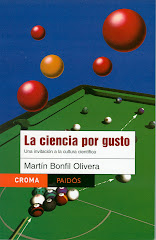by Martín Bonfil Olivera
Published on Milenio Diario, October 22, 2008
 Rarely does a scientific discovery drastically change the contents of school books. Normally, the advances of science, with their slow but constant refining and their very rare revolutions, take years to be reflected in books.
Rarely does a scientific discovery drastically change the contents of school books. Normally, the advances of science, with their slow but constant refining and their very rare revolutions, take years to be reflected in books.
But the discovery that the team leaded by Jeffrey Bada, from Scripps Institution, which involves the participation of Mexican biologist Antonio Lazcano, from UNAM (Science, October 17), will surely change Biology books.
It deals with, as reported by MILENIO Diario, the re-analysis of the results from the classical experiment about the origins of life performed by Stanley Miller in 1953. It consisted of the introduction, into a very simple apparatus, of water and several of the gases that, back then, were supposed to have formed the atmosphere of the primitive earth (methane, hydrogen and ammonia), around four billion years ago. This mixture was boiled and re-circulated for several days and also exposed to electric discharges . After that, the mixture was analyzed with the methods current in those days; in it, five amino acids (units that form the proteins, essential molecules for living beings) were found.
What Bada's team found when checking the samples stored by Miller together with his laboratory log was that, apart from the classic experiment, there were two variants that were not reported. In one of them, the gases, instead of simply circulating, were injected in a jet to the chamber where the electric discharge was occurring.
It is today's belief that the primitive atmosphere did not have the composition that Miller thought. But the jet apparatus simulates the conditions of a volcano, where these gases are indeed found. And a lot of times, the eruptions are accompanied by lightning. In the "volcanic" experiment, with today's modern methods, twenty two amino acids were found. With this, we now have a new option to explain the appearance of molecules that formed the living beings.
(translated by Adrián Robles Benavides)
To receive Science for pleasure weekly
in your email, subscribe here!





No comments:
Post a Comment